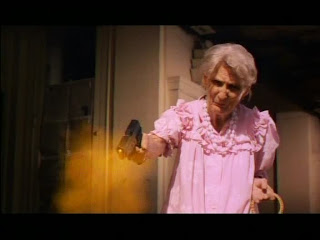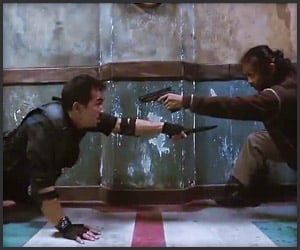
I wanted to like “Society” more than I did. I enjoy Brian Yuzna’s style of filmmaking and feel his strange and outlandish imagery can be grotesquely beautiful. I’d even go on record to say that the outrageous imagery on display here is done fantastically. My problem is, for once, I felt it wasn’t necessary in one of his films.
With the way the story had been built, there were two ways to go. Bill Whitney (Billy Warlock, who is the lovechild of John Stamos and Emilio Estevez) feels like an outcast in his family. Despite his many successes (such as in basketball and being the next class President), he’s always felt his parents gave more attention to his sister, Jenny (Patrice Jennings). He’s of the belief that he’s adopted. His school psychiatrist believes he’s becoming slightly paranoid. I began to think the same thing in the first twenty minutes. The way Yuzna was handling the character and his peculiar visions pointed towards Bill descending into madness.

When I felt the film was going this route, I was find with the abnormal imagery that has become Yuzna’s staple. It added to the film and played off of the story well. It’s not a spoiler to reveal that Bill’s delusions are real, as it’s not only revealed within the first twenty minutes, but all of the promotion for this film announces it.
That’s not to say the film is predictable. Yuzna keeps you guessing, occasionally teasing the paranoia, but mostly just screwing with the audience. Any time Bill gets a lead or evidence in his favor, it all disappears out of the blue. This ties in briefly with the paranoia, though it’s pretty easy to tell it’s all a cover up. It’s also pretty easy to tell what is being covered up, though Brian still finds a way to surprise you.
Once the final act kicks in and we find out all of the answers, I was disheartened. I liked the message Yuzna was conveying. I just didn’t like the way he was going about it. The crazy and freakish approach undermined the message for me. That message being that the upper class feel they’re superior and in a society of their own. That they have good breeding. Yuzna didn’t need to incorporate outrageous effects to prove this point, even if it’s his trademark.
“Society” is best described for me as a rusty rollercoaster. It still operates and delivers a few thrills. However, it’s too bumpy and can cause fits of discomfort. Discomfort may be a positive for most Yuzna films, but it’s not here. As great and disgusting as the effects were, they didn’t captivate me like they did in some of his other work. Here, they just didn’t seem to serve the right purpose.

MVT: As great as the effects are, I didn’t feel they quite fit in with the outcome. Therefore, my MVT is Billy Warlock. He may have been a bit uneven in spots, but he played a likable lead who I could get behind. With a bit more seasoning, he could have been a bigger star. Too bad that never panned out.
Make or Break: The final act broke the film for me. Broke is a bit too harsh of a word, but it’s what I have to use. It certainly didn’t make the film for me.
Final Score: 5/10









































